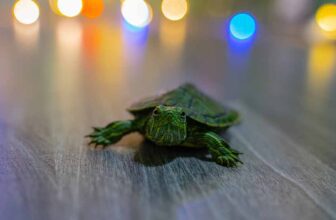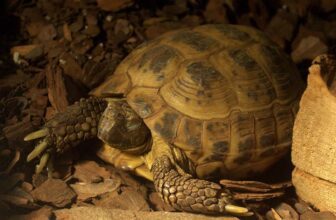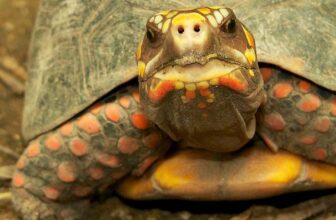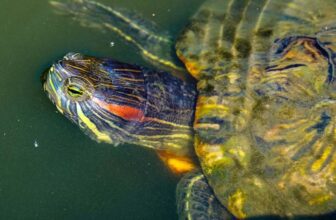Are you interested to know about the top 10 facts about the Sulcata Tortoise? Keep reading to know more. The Sulcata Tortoise, known as African spurred tortoise in some countries, is a type of species that resides in the deserts of Africa. You will find them commonly in the Sahara Desert, especially, in the southern areas. Apart from deserts, the Sulcata tortoise resides in other dry and hot regions in Africa. Currently, this species is regarded as “vulnerable.” This means, they could fall into the “endangered” category quite soon.
While talking about the top 10 facts about Sulcata Tortoise, it is important to talk about the main reasons why these tortoises have become vulnerable. Poachers kill these tortoises in large numbers, because the shells and body parts of this species are in great demand worldwide. The pet trade business and the loss of habitat are also reasons for the staggering decrease in the number of Sulcata Tortoise species in the world today.
One of the best parts about this animal is that it is considered a symbol of prosperity in the African nation of Senegal. This article will give you a brief overview of this species of tortoise, its diet, lifespan, and other facts.
Top 10 facts about Sulcata Tortoise
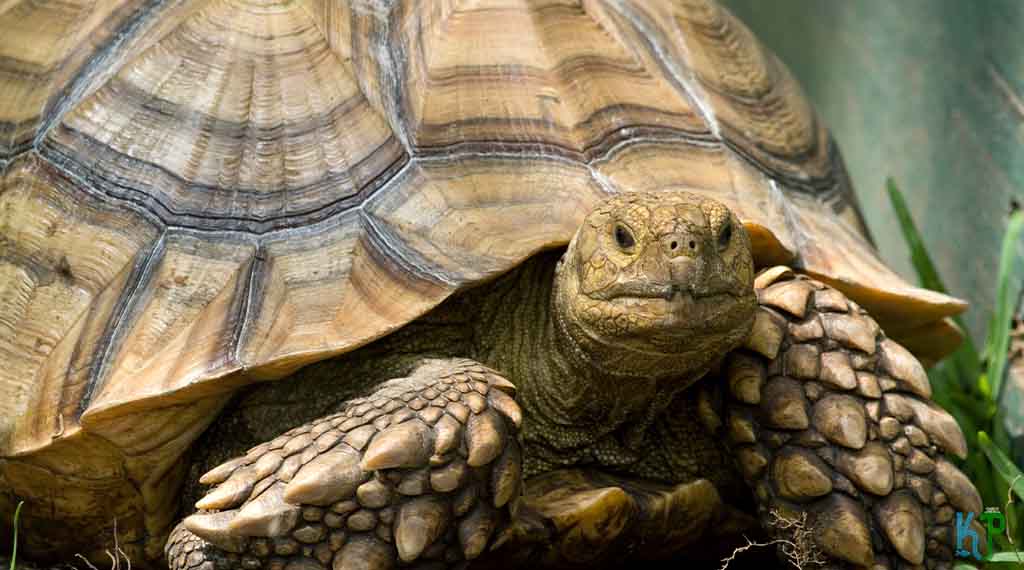
1. Where does Sulcata Tortoise live
While talking about the top 10 facts about Sulcata tortoise, the first point you should know is their place of origin. Though the Sulcata tortoises are natives of the Sahara desert, they can also be found in the arid and semi-arid grasslands, hot savannahs and scrubs found across the northern region of Africa. Their sizes are huge and they are known to survive well in harsh conditions.
Since they live in extremely hot conditions, these tortoises are clever enough to dig burrows in the ground to protect them from the heat. An important fact about these tortoises is that they can dig tunnels up to 10 feet deep in the ground. These tunnels and burrows are cool and damp. The bodies of these tortoises are naturally blessed with a regulated urine system, which controls the quantity of urine that is expelled. This prevents the tortoises from getting dehydrated in the hot conditions.
2. Name reason – one of the most interesting of the top 10 facts about the Sulcata Tortoise
Have you ever wondered where these tortoises got their name from? The word Sulcata, is derived from the Latin word, sulcus, meaning furrows. These tortoises have been named this way because of the large number of furrows or lines found on their shells. This is also one of the unique features that separate the Sulcata Tortoise from other species of tortoises.
The other name for Sulcata Tortoise is the African Spurred Tortoise. The hind legs of this species of tortoise contain spurs, which refers to the sticky pieces that hang out. Therefore, they are known as a spurred tortoise. Usually, you will find two or three conical-shaped spurs towards the back thighs of these tortoises. The front legs, however, contain big scales and not spurs. Since they are natives of Africa’s Sahara desert, it is only natural that they have been named African Spurred Tortoises.
An interesting fact about these tortoises is that though their conservation status is marked as “vulnerable” currently, they are still the third biggest tortoise species in the world today. The first and second biggest species are the Galapagos Tortoise and Aldabra Giant Tortoise respectively.
3. Sulcata Tortoise Diet
The Sulcata tortoise is a herbivorous species, and it eats only plants and scrubs found in the desert region. Succulent plants, grasses and other desert-vegetation form the major part of the Sulcata Tortoise diet. They don’t show great interest in drinking water, as they absorb most of the water from the plants they eat.
A surprising factor about the Sulcata Tortoise is that they can go without food and water for many days. Their bodies are designed in such a way that they can conserve the energy they get from their foods for a long time. Their movements are very slow, which helps them use very little energy while moving from one place to another.
However, when they find some rare food and water sources in their area, they eat and drink like a glutton. The food and water they consume in a single time contribute to almost 15% of their total body weight. They save all the energy that they get from their ravenous meal in their body, because the food sources are quite rare in their habitats.
While they are in the wild, they eat many grasses, cactus plants, weeds and flowers. However, when held captive in zoos, the African Spurred Tortoise food list usually contains various types of leaves, lettuce, all ranges of grasses, berseem and the like.
4. Sulcata Tortoise Size
This species of tortoise can grow to be huge. The average Sulcata Tortoise size is a length of around 24 to 36 inches. While the female tortoise can grow to 19 to 20 inches, the male can grow up to 31 to 35 inches long.
If you thought that the Sulcata Tortoise size in terms of length was quite impressive, wait until you hear the weight of this species. The average weight of a Sulcata Tortoise, full-grown, can be anywhere in the range between 100 and 2oo pounds.
5. Shape of the Sulcata Tortoise
Did you know that you can guess the age of a Sulcata Tortoise fully grown by just looking at its body? The exterior part of this tortoise is very broad, making this species look bigger than it is. You will find a lot of scales on this oval-shaped exterior portion of the Sulcata Tortoise’s body. In scientific terms, these scales are known as scutes. Around these scutes, you will find unique ring-like structures.
These rings are known as the growth rings, because they keep increasing in number as the tortoise keeps growing. Here is one of the most interesting of the top 10 facts about Sulcata tortoise – if you want to calculate its age, all you need to do is count the number of the growth rings on its body. This will help you to determine the animal’s age.
6. Sulcata Tortoise’s lifestyle
Do you want to know how long these tortoises live? According to experts, the Sulcata tortoise lifespan ranges from 50 to 150 years in the wild. By nature, this species belongs to the crepuscular type. This means, these tortoises are very active only during dawn and dusk. They remain quite dull during the rest of the hours.
Despite living in the hot desert and arid regions, the Sulcata Tortoise remains dormant when the climate is hot. The only time when this animal is active is during the rainy season (months between July and October). During the monsoon season, food and water resources are easily available for this species. It eats and drinks as much as it wants, and stores the same as energy in its body, to be used during the hot summers.
During the excruciatingly hot summers, these tortoises spend their time in aestivation. This refers to the resting or dormant period of the SulcataTortoises. They stay within their burrows or tunnels when the external conditions are extremely hot and humid. This trend continues all through the Sulcata tortoise lifespan.These tortoises also use these burrows to hide when the climate is extremely cold.
7. Mating of Sulcata tortoises
One of the top 10 facts about Sulcata tortoise that most people are interested in is about the male and female tortoises’ mating. The mating season of this species is the season right after the monsoon. The months between September and November are the ideal mating season of Sulcata tortoises. You need to know this when you are caring for Sulcata tortoise.
Since the males are aggressive and polygamous, they try to ram into as many females as they want to mark their territory. At the end of the mating season, a female lays about 15 to 30 eggs in a batch. Another interesting point to know about the top 10 facts about Sulcata tortoise is that, the mother covers these eggs and incubates them for about 9 months. The eggs hatch, and the hatchlings grow out of them in about 90 to 180 days.
8. Sulcata Tortoises are Careful mothers
When you are caring for Sulcata tortoise, you should know that the female digs at least 4 to 5 nests under the ground to come up with the best nest for her 30 babies. The babies are 2 inches long at birth, but they grow very quickly. At 15 years, they attain sexual maturity.
9. Sulcata Tortoise for sale
Since they take about 15 years to reach sexual maturity, it is the juvenile tortoises that are quite popular in the pet trade today. A few years ago, they were one of the most common pets in North America. You can find authorized pet trade sites offering Sulcata Tortoise for sale at different price ranges. Usually, they are sold anywhere between $50 and $1000.
10. Extreme heat can kill Sulcata Tortoise
Though they are natives of the extremely hot Sahara Desert in Africa, the Sulcata tortoise is prone to heat strokes. This is why they hide in burrows and tunnels underground. However, if they are exposed to extreme heat, their lives are at great risk, especially if they lie on their backs. We hope these interesting top 10 facts about Sulcata Tortoise have helped you understand this species better than before. If you consider buying them as pets, always contact authorized pet organizations and websites to avoid regrets later.
Conclusion:
In conclusion, the Sulcata Tortoise is a fascinating species that has many interesting and unique characteristics. From their impressive size and long lifespan to their love of digging and basking in the sun, these tortoises make great pets for experienced keepers. However, it is important to understand the challenges of caring for such a large and long-lived animal before deciding to bring one into your home. Overall, the Sulcata Tortoise is a beloved species that has captured the hearts of many reptile enthusiasts around the world.
Frequently Asked Questions:
Can sulcata tortoises eat timothy hay?
While timothy hay is commonly fed to herbivorous animals such as rabbits and guinea pigs, it is not an ideal food for Sulcata Tortoises. These tortoises require a diet that is high in fiber and low in protein, and timothy hay does not meet these requirements. It is best to stick to feeding them a variety of grasses, hay, and vegetables that are specifically recommended for Sulcata Tortoises.
Can sulcata tortoises eat bell peppers?
Yes, Sulcata Tortoises can eat bell peppers as part of a balanced diet. Bell peppers are high in vitamin C, fiber, and other nutrients that are beneficial for tortoises. However, they should be fed in moderation as too many can lead to digestive issues. It is important to offer a variety of vegetables and greens to ensure a well-rounded diet.
Can sulcata tortoises eat celery?
Yes, Sulcata Tortoises can eat celery as part of a balanced diet. Celery is low in calories and high in fiber, which can help with digestion. However, it should be fed in moderation as too much celery can lead to digestive issues. It is important to offer a variety of vegetables and greens to ensure a well-rounded diet.



